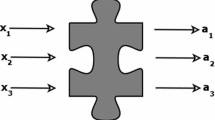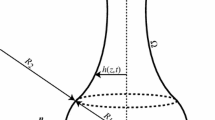Abstract
As an approach to a Theory of Everything a framework for developing a coherent theory of mathematics and physics together is described. The main characteristic of such a theory is discussed: the theory must be valid and and sufficiently strong, and it must maximally describe its own validity and sufficient strength. The mathematical logical definition of validity is used, and sufficient strength is seen to be a necessary and useful concept. The requirement of maximal description of its own validity and sufficient strength may be useful to reject candidate coherent theories for which the description is less than maximal. Other aspects of a coherent theory discussed include universal applicability, the relation to the anthropic principle, and possible uniqueness. It is suggested that the basic properties of the physical and mathematical universes are entwined with and emerge with a coherent theory. Support for this includes the indirect reality status of properties of very small or very large far away systems compared to moderate sized nearby systems. Discussion of the necessary physical nature of language includes physical models of language and a proof that the meaning content of expressions of any axiomatizable theory seems to be independent of the algorithmic complexity of the theory. Gödel maps seem to be less useful for a coherent theory than for purely mathematical theories because all symbols and words of any language must have representations as states of physical systems already in the domain of a coherent theory.
Similar content being viewed by others
REFERENCES
S. Weinberg, Dreams of a Final Theory (Vintage Books, New York, 1994).
B. Greene, The Elegant Universe (Vintage Books, New York, 2000).
J. Casti and A. Karlqvist, eds., Boundaries and Barriers, On the Limits to Scientific Knowledge (Perseus Books, Reading, MA, 1996).
M. Tegmark, Ann. Phys. 270, 1-51 (1998).
J. R. Shoenfield, Mathematical Logic (Addison-Wesley, Reading, MA, 1967).
R. Smullyan, Gödel's Incompleteness Theorems (Oxford University Press, New York, 1992).
K. Gödel, “Ñber formal unentscheidbare Sätze der Principia Mathematica und Vervandter Systeme I,” Monatschefte für Mathematik und Physik 38, 173-198 (1931).
A. A. Frankel, Y. Bar-hillel, A. Levy, and D. van Dalen, Foundations of Set Theory, 2nd revised edn. (Studies in Logic and the Foundations of Mathematics, Vol 67) (North-Holland, Amsterdam, 1973).
P. Benioff, J. Math. Phys. 17, 618, 629 (1976).
J. Väänänen, Bull. Symbolic Logic 7, 504-519, (2001).
P. Benioff, Phys. Rev. A 59, 4223 (1999).
A. Heyting, Intuitionism, An Introduction, 3rd revised edn. (North-Holland, New York, 1971).
E. Bishop, Foundations of Constructive Analysis (McGraw-Hill, New York, 1967).
M. J. Beeson, Foundations of Constructive Mathematics Metamathematical Studies (Springer, New York, 1985).
R. Penrose, The Emperor's New Mind (Penguin Books, New York, 1991).
P. Davies and R. Hersh, The Mathematical Experience (Birkhäuser, Boston, 1981).
M. Kline, Mathematics, The Loss of Certainty (Oxford University Press, New York, 1980).
W. W Marek and J. Mycielski, “The foundations of mathematics in the twentieth century,” Amer. Math. Monthly 108, 449-468 (2001).
C. H. Papadimitriou, Computational Complexity (Addison-Wesley, Reading, MA, 1994).
D. Deutsch, A. Ekert, and R. Lupacchini, Bulletin Symbolic Logic 6, 265-283 (2000).
P. Shor, in Proceedings, 35th Annual Symposium on the Foundations of Computer Science, S. Goldwasser, ed. (IEEE Computer Society Press, Los Alamitos, CA, 1994), pp. 124-134.
L. K. Grover, Phys. Rev. Lett., 79, 325 (1997). G. Brassard, Science 275, 627 (1997). L. K.
Grover, Phys. Rev. Lett. 80, 4329 (1998).
R. P. Feynman, Int. J. Theoret. Phys. 21, 467 (1982).
C. Zalka, “Efficient simulation of quantum systems by quantum computers,” Los Alamos Archives preprint quant-ph/9603026.
S. Wiesner, “Solutions of many body quantum systems by a quantum computer,” Los Alamos Archives preprint quant-ph/9603028.
D. S. Abrams and S. Lloyd, Phys. Rev. Lett. 79, 2586-2589 (1997).
S. Lloyd, Science 273, 1073-1078 (1996).
R. Landauer, Physics Today 44(5), 23 (1991); Phys. Lett. A 217, 188 (1996); in Feynman and Computation, Exploring the Limits of Computers, A. J. G. Hey, ed. (Perseus Books, Reading, MA, 1998).
P. Bridgman, Nature of Physical Theory (Dover, New York, 1936).
K. Svozil, Found. Phys. 25, 1541 (1995).
D. Finkelstein, Int. J. Theoret. Phys. 31, 1627 (1992); “Quantum sets, assemblies and plexi,” in Current Issues in Quantum Logic, E. Beltrametti and B. van Frassen, eds. (Plenum, New York, 1981), pp. 323-333; Quantum Relativity (Springer, New York, 1994).
G. Takeuti, “Quantum Set theory,” in Current Issues in Quantum Logic, E. G. Beltrametti and B. C. van Fraasen, eds. (Plenum, New York, 1981), pp. 303-322.
H. Nishimura, Int. J. Theoret. Phys. 32, 1293 (1993); 43, 229 (1995).
A. Odlyzko, “Primes, quantum chaos and computers,” in Number Theory, Proceedings of a Symposium, May 4 1989, Washington, D.C., Board on Mathematical Sciences, National Research Council, 1990, pp. 35-46.
R. E. Crandall, J. Phys. A: Math. Gen. 29, 6795 (1996).
S. Okubo, “Lorentz-invariant Hamiltonian and Riemann hypothesis,” Los Alamos Archives, quant-ph/9707036.
Y. Ozhigov, “Fast quantum verification for the formulas of predicate calculus,” Los Alamos Archives Rept. No. quant-ph/9809015.
H. Buhrman, R. Cleve, and A. Wigderson, “Quantum vs. Classical Communication and Computation,” Los Alamos Archives Rept. No. quant-ph/9802040.
C. Schmidhuber, Los Alamos Archives preprint hep-th/0011065.
S. Blaha, “Cosmos and consciousness,” 1stbooks Library, Bloomington, IN, 2000; “A quantum computer foundation for the standard model and superstring theory,” Los Alamos Archives Rept. No. quant-ph/0201092.
D. Spector, J. Math. Phys. 39, 1919 (1998).
L. Foschini, “On the logic of quantum physics and the concept of the time,” Los Alamos Archives Preprint, quant-ph/9804040.
G. W. Mackey, Mathematical Foundations of Quantum Mechanics (Benjamin, New York, 1963).
R. Haag, Local Quantum Physics: Fields, Particles, Algebras (Springer, Berlin, New York, 1992).
G. Birkhoff and J. von Neumann, Ann. Math. 37, 743 (1936).
J. M. Jauch and C. Piron, Helv. Phys. Acta 36, 837 (1963); C. Piron, ibid. 37, 439 (1964).
L. Hardy, Los Alamos Archives Preprint quant-ph/0101012.
E. Wigner, Comm. Pure and Applied Math. 13, 001 (1960); reprinted in E. Wigner, Symmetries and Reflections (Indiana University Press, Bloomington, IN, 1966), pp. 222-237.
P. C. W. Davies, “Why is the physical world so comprehensible?,” in Complexity, Entropy, and Physical Information (Proceedings of the 1988 Work-shop on Complexity, Entropy, and the Physics of Information, May-June 1989, Santa Fe New Mexico), W. H. Zurek, ed. (Addison-Wesley, Redwood City, CA, 1990), pp. 61-70.
C. C. Chang and H. J. Keisler, Model Theory (Studies in Logic and the Foundations of Mathematics, Vol 73) (American Elsevier, New York, NY, 1973), pp. 36-45.
G. Chaitin, Information Theoretic Incompleteness (World Scientific Series in Computer Science, Vol. 35) (World Scientific, Singapore, 1992); Information Randomness &;;; Incompleteness (Series in Computer Science, Vol 8), 2nd edn. (World Scientific, Singapore, 1990); Scientific American 232, 47-52 (1975); American Scientist 90, 164-171 (2002).
P. J. Cohen, Set Theory and the Continuum Hypothesis (Benjamin, New York, NY, 1966).
H. Woodin, Notices, Amer. Math. Soc. 48, 567-576 (2001).
J. Stillwell, Am. Math. Monthly 109, 286-298 (2002).
C. H. Bennett, D. P. DiVincenzo, T. Mor, P. W. Shor, J. A. Smolin, and B. M. Terhal, Phys. Rev. Lett. 82, 5385 (1999). C. H. Bennett, D. P. DiVincenzo, C. A. Fuchs, T. Mor, E. Rains, P. W. Shor, J. A. Smolin, and W. K. Wootters, Phys. Rev A, 59, 1070 (1999).
P. Benioff, Phys. Rev. A 64, #052310 (2001); Los Alamos archives quant-ph/ 0104061.
A. Turing, Proc. London Math. Soc. 42, 230-265 (1936).
D. Deutsch, Proc. Roy. Soc. London, Series A 400, 997 (1985).
E. Bernstein and U. Vazirani, SIAM J. Comput. 26, 1541-1557 (1997).
M. Tegmark, Los Alamos Archives preprint quant-ph/9709032.
H. Everett, Rev. Mod. Phys. 29, 454-462, (1957).
J. A. Wheeler, Rev. Mod. Phys. 29, 463-465, (1957).
H. P. Stapp, Mind, Matter, and Quantum Mechanics (Springer, Berlin, 1993).
E. Squires, Conscious Mind in the Physical World (IOP Publishing, Bristol, England, 1990).
D. Page, Los Alamos Archives preprint quant-ph/0108039.
E. Wigner, “Remarks on the mind-body question,” in The Scientist Speculates, I. Good and W. Heinemann, eds. (Putnam, London, 1962).
D. Albert, Phys. Lett. A 98, 249 (1983); Philos. Sci. 54, 577 (1987); “The quantum mechanics of self-measurement” in Complexity, Entropy and the Physics of Information, (Proceedings of the 1988 workshop in Santa Fe, New Mexico, 1989), W. Zurek, ed. (Addison-Wesley, Redwood City, CA, 1990).
P. Benioff, Phys. Rev. A 63, #032305 (2001).
P. Benioff, Los Alamos Archives preprint, quant-ph/0103078, Accepted for publication in special issue of Algorithmica.
J. D. Barrow and F. J. Tipler, The Anthropic Cosmologic Principle (Oxford University Press, 1989).
C. Hogan, Rev. Mod. Phys. 72, 1149 (2000).
G. Greenstein and A. Kropf, Am. J. Phys. 58, 746 (1989).
P. Benioff, Los Alamos Archives preprint quant-ph/0106153.
P. Benioff, Phys. Rev. A 58, 893-904 (1998).
A. Berthiaume, W. van Dam, and S. Laplante, J. Comp. Syst. Sciences 63, 201-221 (2001).
P. Vitanyi, “Three approaches to the quantitative definition of information in an individual pure quantum state,” Proceedings 15th IEEE Conference on Computational Complexity (Piscatawy, NJ, 2000), pp. 263-270; Los Alamos Archives preprint quant-ph/9907035.
P. Gacs, J. Phys. A, Math Gen. 34, 6859-6880 (2001).
W. V.O. Quine, Mathematical Logic (Norton, 1940).
R. Laflamme, C. Miquel, J. P. Paz, and W. H. Zurek, Phys. Rev. Lett. 77, 198 (1996); D. P. DiVincenzo and P. W. Shor, Phys. Rev. Lett. 77, 3260 (1996). E. M. Raines, R. H. Hardin, P. W. Shor, and N. J. A. Sloane, Phys. Rev. Lett. 79, 954 (1997).
W. H. Zurek, Phys. Rev. D 24, 1516 (1981); 26, 1862 (1982).
E. Joos and H. D. Zeh, Zeit. Phys. B 59, 23 (1985). H. D. Zeh, quant-ph/ 9905004; E. Joos, quant-ph/ 9808008.
Author information
Authors and Affiliations
Rights and permissions
About this article
Cite this article
Benioff, P. Towards a Coherent Theory of Physics and Mathematics. Foundations of Physics 32, 989–1029 (2002). https://doi.org/10.1023/A:1016561108807
Issue Date:
DOI: https://doi.org/10.1023/A:1016561108807




